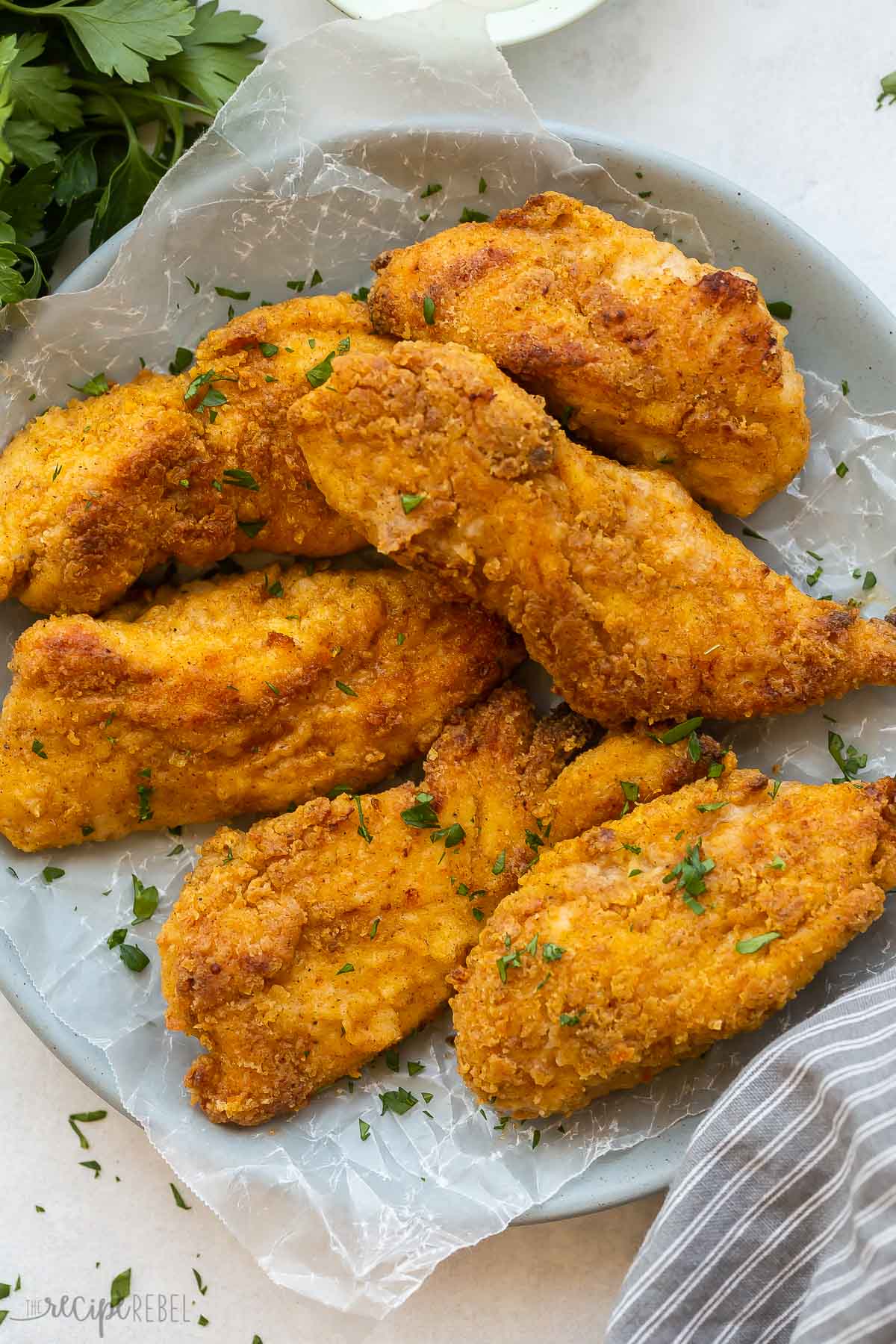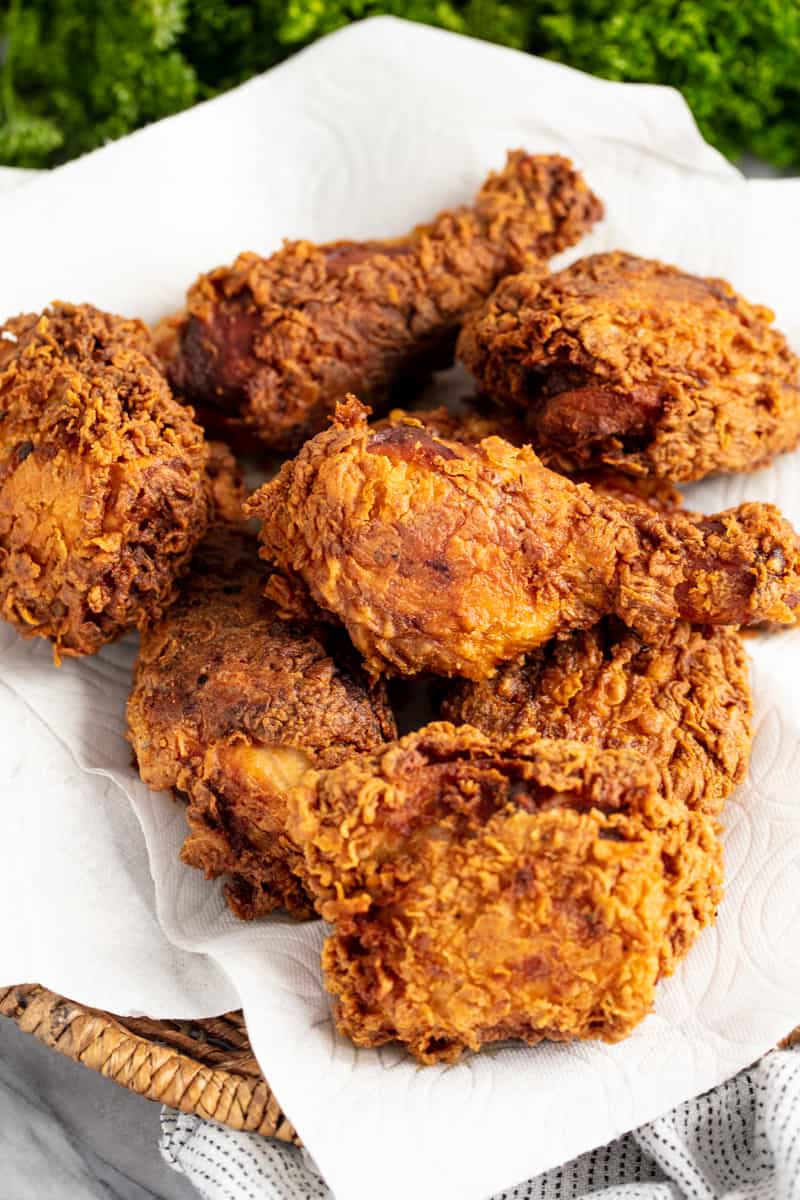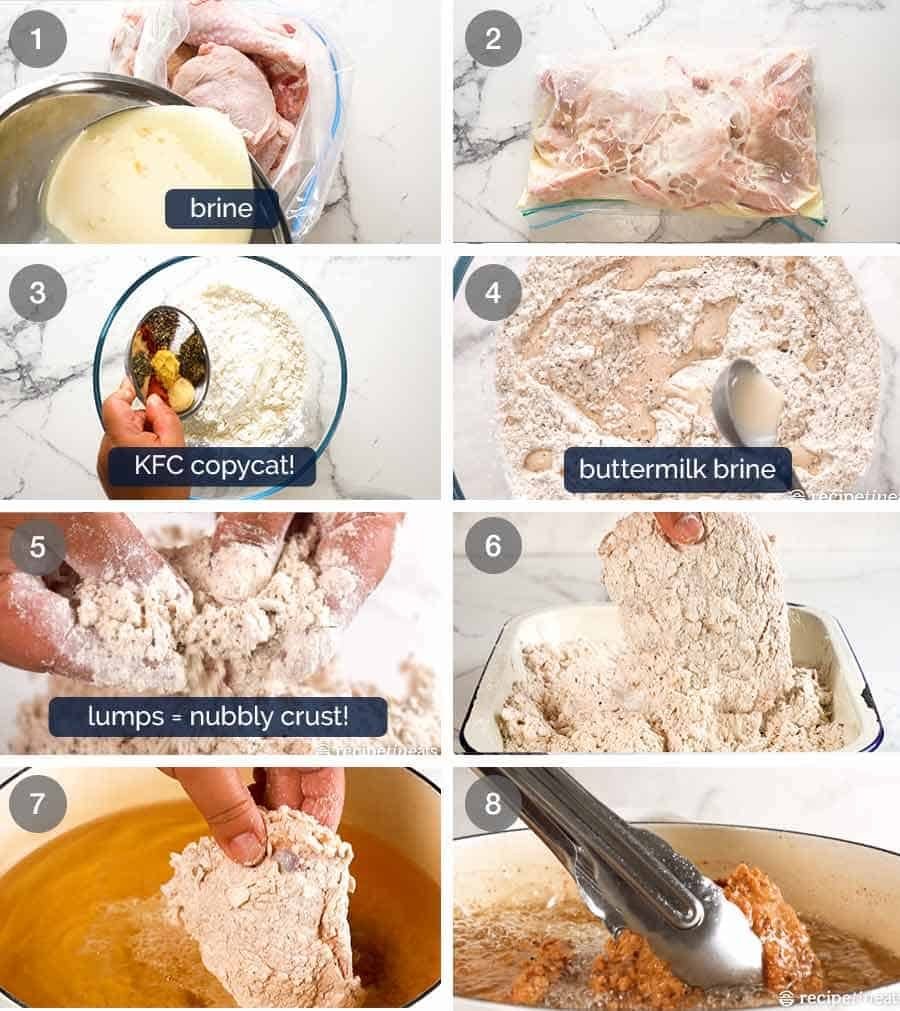Fried chicken is a beloved dish worldwide. It’s crispy, flavorful, and satisfying. Cooking fried chicken at home can be a fun and rewarding experience. With the right tips, you can achieve that perfect golden crust and juicy inside.
This guide will walk you through the steps to make delicious fried chicken. Whether you’re a beginner or an experienced cook, you’ll find helpful advice here.
From choosing the right chicken pieces to mastering the frying technique, we’ve got you covered. Ready to impress your family and friends? Let’s dive into the world of homemade fried chicken!
Choosing The Right Chicken
Cooking fried chicken starts with selecting the right chicken. This step is crucial for a delicious result. The quality of your chicken affects the taste and texture. Here, we will guide you through choosing the best chicken for frying.
Best Cuts For Frying
The best cuts for frying are usually the legs, thighs, and wings. These parts have more fat, making them juicy and flavorful. Boneless chicken breasts can also be used. But they may dry out faster. Drumsticks are a popular choice. They have a good balance of meat and bone. Thighs are rich and tender. Wings are perfect for small, crispy pieces.
Organic Vs. Conventional
Organic chicken is raised without antibiotics and hormones. It often tastes better and is healthier. Conventional chicken is more affordable. But it may not have the same quality. Organic chicken can be more tender. It also supports sustainable farming practices. Conventional chicken can still be tasty. Choose what fits your budget and values. Both types can make delicious fried chicken.
Essential Ingredients
Fried chicken is a beloved dish worldwide. To make it perfect, you need the right ingredients. This section will cover the essential ingredients needed for delicious fried chicken. We will look at the key components, including spices, seasonings, oils, and fats. Each plays a crucial role in creating a crispy, flavorful dish.
Spices And Seasonings
Spices and seasonings are the heart of fried chicken. They provide the unique flavor that makes each bite special. Here are some key spices and seasonings to use:
- Salt: Enhances the overall flavor.
- Black Pepper: Adds a mild heat.
- Paprika: Gives color and a smoky taste.
- Garlic Powder: Adds depth to the flavor.
- Onion Powder: Complements the garlic powder.
- Cayenne Pepper: For those who like it spicy.
- Thyme: Adds a subtle earthy taste.
Mix these spices in a bowl. Adjust the quantities to match your taste preferences. A well-seasoned chicken is key to a great fried chicken.
Oils And Fats
Choosing the right oil or fat is crucial. It affects the texture and taste of your fried chicken. Here are some popular options:
| Oil/Fat | Smoke Point | Flavor Profile |
|---|---|---|
| Vegetable Oil | 400°F (204°C) | Neutral |
| Canola Oil | 400°F (204°C) | Neutral |
| Peanut Oil | 450°F (232°C) | Light, nutty |
| Lard | 370°F (188°C) | Rich, savory |
Ensure you use oil with a high smoke point. This helps achieve the perfect crispy crust. Peanut oil is a great choice due to its high smoke point and light flavor.
Now that you know the essential ingredients, you are one step closer to making delicious fried chicken. Use fresh ingredients for the best results. Mix your spices well and choose the right oil. Happy cooking!
Marinating The Chicken
Marinating the chicken is a crucial step in cooking fried chicken. It enhances the flavor and ensures the meat is juicy and tender. This process involves soaking the chicken in a flavorful liquid mixture for a specific period.
Marinade Recipes
There are many marinade recipes to choose from. A basic marinade includes buttermilk, salt, and pepper. Buttermilk tenderizes the chicken and adds a slight tang. Another popular option is a mix of soy sauce, garlic, and ginger. This gives the chicken an Asian-inspired flavor. For a spicy kick, use hot sauce, paprika, and cayenne pepper. Each recipe offers a unique taste experience.
Marinating Times
Timing is essential for marinating chicken. For best results, marinate the chicken for at least 30 minutes. Overnight marinating is ideal as it allows the flavors to fully penetrate the meat. If you’re short on time, even 15 minutes can make a difference. Remember, the longer the chicken marinates, the more flavorful it becomes.
Preparing The Coating
Cooking delicious fried chicken starts with preparing the perfect coating. This step is crucial for achieving that crispy, golden-brown crust we all love. Below, we’ll guide you through the process of creating the ideal coating with simple instructions.
Flour Mixtures
The first step in preparing the coating is to create a flour mixture. This mixture will form the base of your fried chicken coating. Here’s a simple recipe to get you started:
| Ingredient | Quantity |
|---|---|
| All-purpose flour | 2 cups |
| Salt | 1 teaspoon |
| Black pepper | 1 teaspoon |
| Garlic powder | 1 teaspoon |
| Paprika | 1 teaspoon |
| Onion powder | 1 teaspoon |
Combine these ingredients in a large bowl. Mix well to ensure the spices are evenly distributed throughout the flour.
Breading Techniques
Once your flour mixture is ready, it’s time to bread the chicken. Follow these steps for a perfect coating:
- Prepare the chicken: Rinse and pat dry each piece of chicken. This helps the coating stick better.
- Dredge in flour: Coat each piece of chicken in the flour mixture. Shake off any excess flour.
- Dip in egg wash: Create an egg wash using 2 eggs and 1/4 cup of milk. Dip each floured piece of chicken into the egg wash.
- Coat again: Return the chicken to the flour mixture for a second coating. Press the flour mixture onto the chicken to ensure a thick, even layer.
These steps will give your fried chicken a crispy, flavorful coating. Make sure to follow each step carefully for the best results.
Setting Up The Frying Station
Before cooking your delicious fried chicken, you need to set up a proper frying station. This will help you cook efficiently and keep your kitchen organized. Let’s dive into the essentials for setting up your frying station.
Tools And Equipment
Having the right tools and equipment is crucial for cooking perfect fried chicken. Here’s a list of what you’ll need:
- Deep Fryer or Large Heavy Pot: Use a deep fryer or a large, heavy pot for even cooking.
- Thermometer: A kitchen thermometer helps maintain the correct oil temperature.
- Tongs: Use tongs to handle the chicken without burning your hands.
- Wire Rack: Place cooked chicken on a wire rack to drain excess oil.
- Paper Towels: Use paper towels to blot off any extra grease.
- Mixing Bowls: Have several mixing bowls ready for breading the chicken.
Safety Tips
Safety is key when frying chicken. Follow these tips to stay safe:
- Keep the Area Clean: Clean your work area to avoid accidents.
- Monitor Oil Temperature: Keep the oil between 350°F and 375°F.
- Use Proper Tools: Avoid using plastic utensils that can melt.
- Avoid Overcrowding: Fry only a few pieces at a time to maintain oil temperature.
- Stay Alert: Never leave the frying station unattended.
- Have a Fire Extinguisher: Keep a fire extinguisher nearby in case of emergencies.
Setting up your frying station with the right tools and following safety tips ensures a smooth cooking process. Now you’re ready to cook delicious fried chicken with confidence!
:max_bytes(150000):strip_icc()/8841-Oven-Fried-Chicken-ddmfs-4x3-104184-1633bf02818a49f9818732cba77216c6.jpg)
Credit: www.allrecipes.com
Frying Techniques
Frying chicken can be an art. The right technique ensures crispy, juicy results. We’ll explore two key aspects: temperature control and batch frying.
Temperature Control
Maintaining the right oil temperature is crucial. Use a thermometer to monitor the heat. The ideal range is 350°F to 375°F.
If the oil is too hot, the chicken burns outside but stays raw inside. Too cold and it becomes greasy and soggy.
Adjust the heat as needed. This helps keep the temperature steady. Consistent heat ensures even cooking and a perfect crust.
Batch Frying
Fry the chicken in small batches. Overcrowding the pan drops the oil temperature. This leads to uneven cooking.
Give each piece enough space. This ensures they cook evenly and become crispy. Patience is key.
After each batch, let the oil return to the right temperature. Then, add the next batch. This keeps the cooking process consistent.
Testing For Doneness
Cooking fried chicken to perfection requires more than just following a recipe. Ensuring your chicken is fully cooked is crucial for both taste and safety. There are several ways to check if your fried chicken is done. This section will cover two main methods: Internal Temperature and Visual Cues.
Internal Temperature
Using a meat thermometer is the most reliable way to check for doneness. Insert the thermometer into the thickest part of the chicken, avoiding bones. The internal temperature should read 165°F (74°C) to ensure the chicken is safe to eat.
| Chicken Part | Target Temperature |
|---|---|
| Breast | 165°F (74°C) |
| Thigh | 165°F (74°C) |
| Wing | 165°F (74°C) |
Check multiple pieces to ensure uniform cooking. Always wash the thermometer after use to prevent cross-contamination.
Visual Cues
Visual cues can help if you do not have a thermometer. Look for these signs:
- Golden Brown Color: The chicken should be a deep golden brown.
- Firm Texture: The meat should feel firm, not squishy.
- Clear Juices: Pierce the chicken; the juices should run clear, not pink.
These visual cues can guide you, but always double-check with a thermometer when possible.
By following these methods, you can ensure your fried chicken is both delicious and safe to eat.
Serving Suggestions
Serving fried chicken can be a delightful experience. The right sides and sauces elevate your meal. Let’s explore some delicious serving suggestions.
Side Dishes
Fried chicken pairs well with a variety of side dishes. Here are some popular choices:
- Mashed Potatoes: Creamy and smooth, they complement the crunchy chicken.
- Coleslaw: Fresh and tangy, it adds a refreshing contrast.
- Macaroni and Cheese: Cheesy and comforting, it’s a favorite for all ages.
- Biscuits: Fluffy and warm, perfect for soaking up any extra gravy.
- Green Beans: Lightly sautéed, they add a healthy touch to your meal.
Dipping Sauces
Dipping sauces can make fried chicken even more enjoyable. Consider these options:
- Barbecue Sauce: Sweet and smoky, it adds a burst of flavor.
- Ranch Dressing: Creamy and herby, it’s a classic choice.
- Honey Mustard: Sweet and tangy, it’s perfect for a little zing.
- Hot Sauce: Spicy and bold, for those who like heat.
- Garlic Aioli: Rich and garlicky, it’s a gourmet touch.
Experiment with these side dishes and dipping sauces. Create a memorable meal that everyone will love.
Storing Leftovers
Fried chicken is delicious, but sometimes you end up with leftovers. Properly storing your leftover fried chicken is essential to maintain its taste and safety. Below are some tips for refrigerating and reheating your fried chicken to ensure it remains as tasty as possible.
Refrigeration Tips
- Cool down the chicken: Allow the fried chicken to cool at room temperature for 20-30 minutes. This prevents condensation in the container.
- Use airtight containers: Place the cooled chicken pieces in airtight containers to keep them fresh.
- Layer with paper towels: Place a paper towel at the bottom of the container to absorb excess moisture.
- Label the container: Write the date on the container so you know how long it has been stored.
- Refrigerate promptly: Place the container in the fridge within two hours of cooking.
Reheating Methods
Reheating fried chicken can be tricky. You want to keep it crispy without drying it out. Here are some effective methods:
| Method | Instructions |
|---|---|
| Oven | Preheat the oven to 375°F. Place the chicken on a baking sheet. Bake for 10-15 minutes. Check the internal temperature to ensure it reaches 165°F. |
| Air Fryer | Preheat the Air Fryer to 375°F. Place the chicken in the basket. Heat for 8-10 minutes. |
| Stovetop | Heat a skillet over medium heat. Add a small amount of oil. Fry the chicken for 3-5 minutes per side. |
| Microwave | Place the chicken on a microwave-safe plate. Cover with a damp paper towel. Heat on high for 1-2 minutes. The microwave might not keep it as crispy. |
Following these tips ensures your leftover fried chicken remains delicious. Enjoy your meal the next day without compromising on taste!

Credit: www.thereciperebel.com

Credit: thestayathomechef.com
Frequently Asked Questions
How Do You Make Fried Chicken Crispy?
To make fried chicken crispy, use a buttermilk marinade and coat with seasoned flour. Fry at 350°F until golden brown. Ensure the oil is hot enough to create a crispy crust.
What Oil Is Best For Frying Chicken?
Use oils with high smoke points like peanut, canola, or vegetable oil. These oils withstand high temperatures, ensuring your chicken fries evenly without burning.
How Long Should You Fry Chicken?
Fry chicken pieces for about 12-15 minutes. Ensure internal temperature reaches 165°F. Adjust time based on the size of the chicken pieces.
Should You Marinate Chicken Before Frying?
Yes, marinating chicken enhances flavor and tenderness. Use buttermilk or a seasoned brine for at least 2 hours, preferably overnight, before frying.
Conclusion
Cooking fried chicken can be easy and fun. Follow the steps, and you’ll enjoy delicious, crispy chicken at home. Practice makes perfect. Don’t be afraid to experiment with spices and techniques. Share your homemade fried chicken with friends and family.
They’ll love it. Remember to keep safety in mind while frying. Happy cooking!


